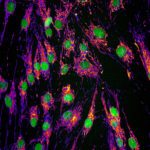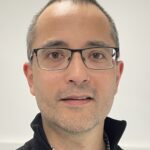Link to Pubmed [PMID] – 17222701
Curr. Top. Dev. Biol. 2007;77:87-111
In mammals, mitochondria and mitochondrial DNA (mtDNA) are transmitted through the female germ line. Mature oocytes contain at least 100,000 copies of mtDNA, organized at 1-2 copies per organelle. Despite the high genome copy number, mtDNA sequence variants are observed to segregate rapidly between generations, and this has led to the concept of a developmental bottleneck for the transmission of mtDNA. Ultrastructural investigations of primordial germ cells show that they contain approximately 10 mitochondria, suggesting that mitochondrial biogenesis is arrested during early embryogenesis, and that the mitochondria contributing to the germ cell precursors are simply apportioned from those present in the zygote. Thus, as few as 0.01% of the mitochondria in the oocyte actually contribute to the offspring of the next generation. Mitochondrial replication restarts in the migrating primordial germ cells, and mitochondrial numbers steadily increase to a few thousand in primordial oocytes. Genetic evidence from both heteroplasmic mice and human pedigrees suggests that segregation of mtDNA sequence variants is largely a stochastic process that occurs during the mitotic divisions of the germ cell precursors. This process is essentially complete by the time the primary oocyte population is differentiated in fetal life. Analysis of the distribution of pathogenic mtDNA mutations in the offspring of carrier mothers shows that risk of inheriting a pathogenic mutation increases with the proportion in the mother, but there is no bias toward transmitting more or less of the mutant mtDNAs. This implies that there is no strong selection against oocytes carrying pathogenic mutations and that atresia is not a filter for oocyte quality based on oxidative phosphorylation capacity. The large number of mitochondria and mtDNAs present in the oocyte may simply represent a genetic mechanism to ensure their distribution to the gametes and somatic cells of the next generation. If true, mtDNA copy number, and by inference mitochondrial number, may be the most important determinant of oocyte quality, not because of the effects on oocyte metabolism, but because too few would result in a maldistribution in the early embryo.

